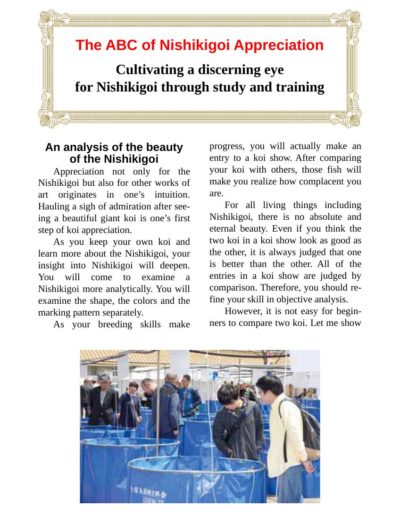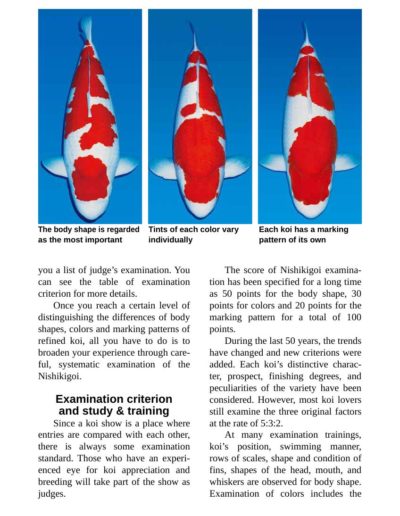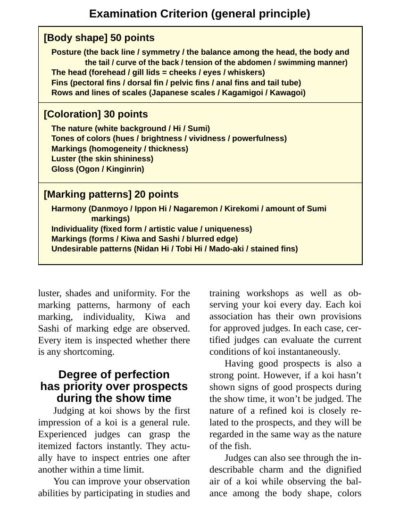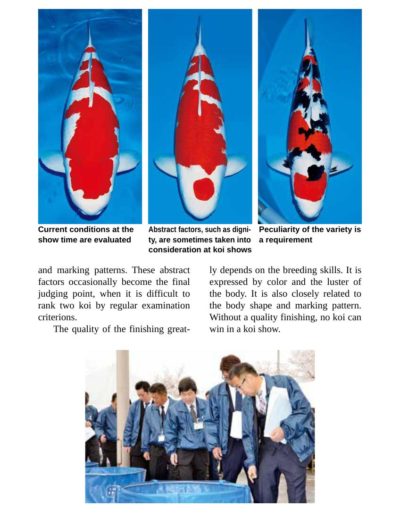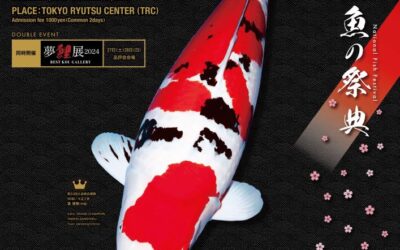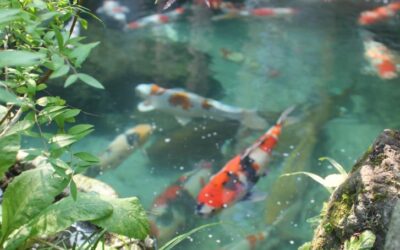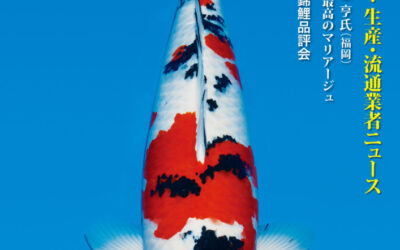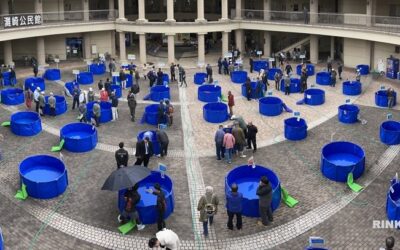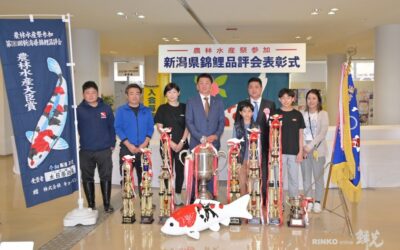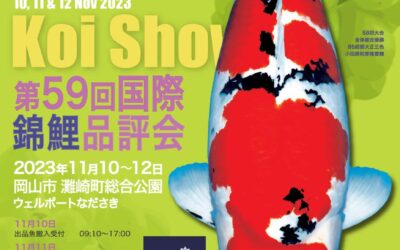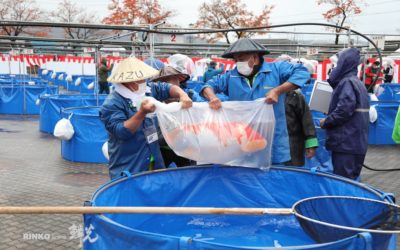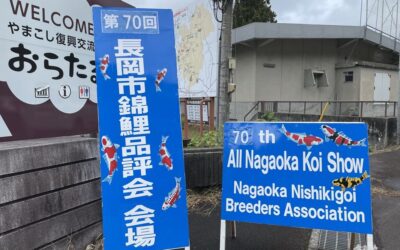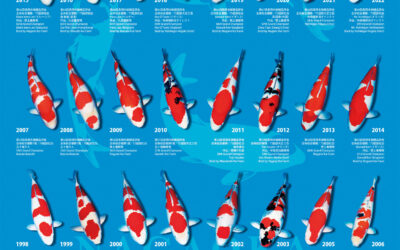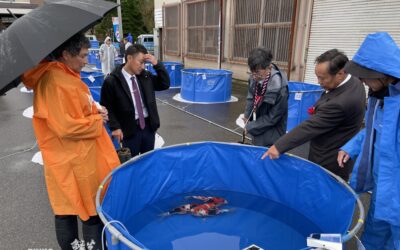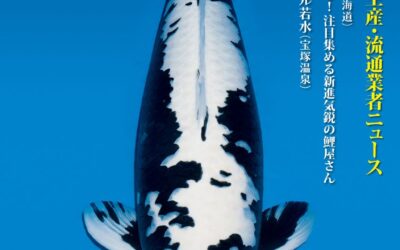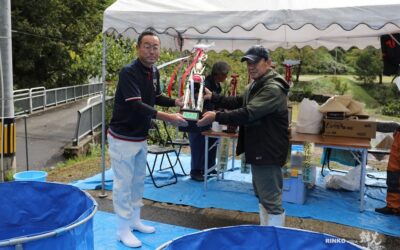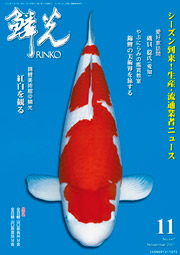The ABC of Nishikigoi Appreciation
Cultivating a discerning eye for Nishikigoi through study and training
An analysis of the beauty of the Nishikigoi
Appreciation not only for the Nishikigoi but also for other works of art originates in one’s intuition. Hauling a sigh of admiration after seeing a beautiful giant koi is one’s first step of koi appreciation.
As you keep your own koi and learn more about the Nishikigoi, your insight into Nishikigoi will deepen. You will come to examine a Nishikigoi more analytically. You will examine the shape, the colors and the marking pattern separately.
As your breeding skills make progress, you will actually make an entry to a koi show. After comparing your koi with others, those fish will make you realize how complacent you are.
For all living things including Nishikigoi, there is no absolute and eternal beauty. Even if you think the two koi in a koi show look as good as the other, it is always judged that one is better than the other. All of the entries in a koi show are judged by comparison. Therefore, you should refine your skill in objective analysis.
However, it is not easy for beginners to compare two koi. Let me show you a list of judge’s examination. You can see the table of examination criterion for more details.
Once you reach a certain level of distinguishing the differences of body shapes, colors and marking patterns of refined koi, all you have to do is to broaden your experience through careful, systematic examination of the Nishikigoi.
Examination criterion and study & training
Since a koi show is a place where entries are compared with each other, there is always some examination standard. Those who have an experienced eye for koi appreciation and breeding will take part of the show as judges.
The score of Nishikigoi examination has been specified for a long time as 50 points for the body shape, 30 points for colors and 20 points for the marking pattern for a total of 100 points.
During the last 50 years, the trends have changed and new criterions were added. Each koi’s distinctive character, prospect, finishing degrees, and peculiarities of the variety have been considered. However, most koi lovers still examine the three original factors at the rate of 5:3:2.
At many examination trainings, koi’s position, swimming manner, rows of scales, shape and condition of fins, shapes of the head, mouth, and whiskers are observed for body shape. Examination of colors includes the luster, shades and uniformity. For the marking patterns, harmony of each marking, individuality, Kiwa and Sashi of marking edge are observed. Every item is inspected whether there is any shortcoming.
Degree of perfection has priority over prospects during the show time
Judging at koi shows by the first impression of a koi is a general rule. Experienced judges can grasp the itemized factors instantly. They actually have to inspect entries one after another within a time limit.
You can improve your observation abilities by participating in studies and training workshops as well as observing your koi every day. Each koi association has their own provisions for approved judges. In each case, certified judges can evaluate the current conditions of koi instantaneously.
Having good prospects is also a strong point. However, if a koi hasn’t shown signs of good prospects during the show time, it won’t be judged. The nature of a refined koi is closely related to the prospects, and they will be regarded in the same way as the nature of the fish.
Judges can also see through the indescribable charm and the dignified air of a koi while observing the balance among the body shape, colors and marking patterns. These abstract factors occasionally become the final judging point, when it is difficult to rank two koi by regular examination criterions.
The quality of the finishing greatly depends on the breeding skills. It is expressed by color and the luster of the body. It is also closely related to the body shape and marking pattern. Without a quality finishing, no koi can win in a koi show.
Examination Criterion (general principle)
| [Body shape] 50 points Posture (the back line / symmetry / the balance among the head, the body and the tail / curve of the back / tension of the abdomen / swimming manner) The head (forehead / gill lids = cheeks / eyes / whiskers) Fins (pectoral fins / dorsal fin / pelvic fins / anal fins and tail tube) Rows and lines of scales (Japanese scales / Kagamigoi / Kawagoi) |
| [Coloration] 30 points The nature (white background / Hi / Sumi) Tones of colors (hues / brightness / vividness / powerfulness) Markings (homogeneity / thickness) Luster (the skin shininess) Gloss (Ogon / Kinginrin) |
| [Marking patterns] 20 points Harmony (Danmoyo / Ippon Hi / Nagaremon / Kirekomi / amount of Sumi markings) Individuality (fixed form / artistic value / uniqueness) Markings (forms / Kiwa and Sashi / blurred edge) Undesirable patterns (Nidan Hi / Tobi Hi / Mado-aki / stained fins) |
Enjoy our collection of articles on Japanese koi news, updates, winners, educational articles, definitions and more!
Join as a free RINKO Member for increased access and subscribe as a paid member for full access to our content.
54th All Japan Koi Show New Size Group and Categories
by RINKO online | Dec 19, 2023
The 54th All Japan Koi Show will be held on 27th-28th January 2024 at Tokyo...
Japanese RINKO are available at RINKO online now
by RINKO online | Dec 15, 2023
It's been a while since last post as we've been through the busiest season....
Japanese RINKO 2023 December issue adverts
by RINKO online | Nov 24, 2023
Japanese RINKO 2023 December issue adverts 鱗光 2023年12月号掲載広告
ZNA 59th International Koi Show Recap
by RINKO online | Nov 16, 2023
ZNA 59th International Koi Show was held at Okayama Well-port Nadasaki on...
63rd Niigata Nogyosai Koi Show was held at Ojiya Gymnasium on 4-5th November.
by RINKO online | Nov 8, 2023
63rd Niigata Nogyosai Koi Show was held at Ojiya Gymnasium on 4-5th...
ZNA (Zen Nippon Airinkai) 全日本愛鱗会
by RINKO online | Nov 7, 2023
ZNA (Zen Nippon Airinkai) 全日本愛鱗会 ZNA is an internaional koi club based in...
Nogyosai 農業祭
by RINKO online | Oct 31, 2023
Nogyosai 農業祭 Nogyosai means agricultural festival, the term is well known as...
70th Nagaoka City Koi Show Recap
by RINKO online | Oct 31, 2023
70th Nagaoka City Koi ShowThe 70th Nagaoka City Koi Show was held at Yamakoshi...
The 70th Nagaoka City Koi Show scheduled on October 29
by RINKO online | Oct 24, 2023
The 70th Nagaoka City Koi Show scheduled on October 29 ** This article is...
42nd Uonuma Koi Show
by RINKO online | Oct 23, 2023
The 42nd Uonuma City Koi Show was held at JA Kita Uonuma on 21st Oct.Murata...
Japanese RINKO 2023 November issue adverts
by RINKO online | Oct 17, 2023
Japanese RINKO 2023 November issue adverts 鱗光 2023年11月号掲載広告
Yomogihira Young Koi Show 2023
by RINKO online | Oct 12, 2023
Yomogihira Young Koi Show was held on 7th Oct. Koi Season has started! Marusho...
RINKO Koi Magazine is NOW available online!
Blog Categories
Reminder: You must login or register for website to vote in our polls.

